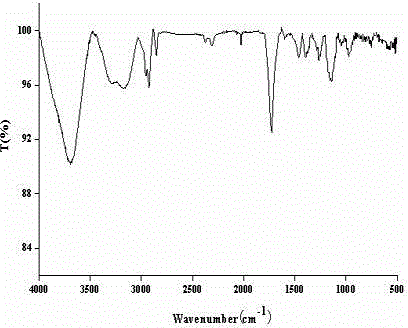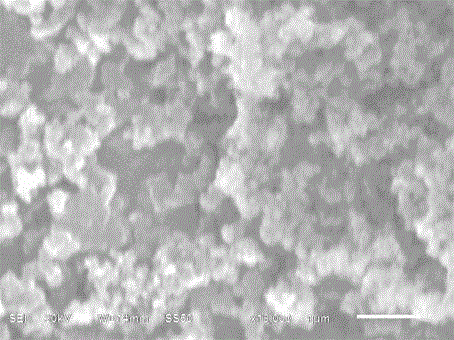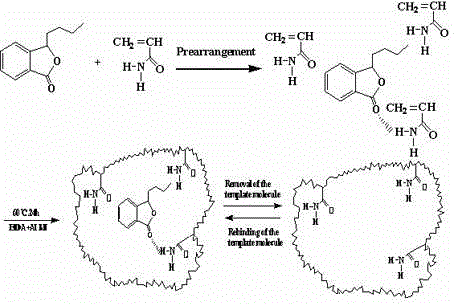Printed material having high affinity and high identification capability on butylphthalide and preparation method of printed material
An imprinted material, apigenin A technology, applied in chemical instruments and methods, other chemical processes, etc., can solve the problems of inability to use trace substances to purify, low efficiency of apigenin A, poor selectivity, etc., and achieve easy operation and high affinity The effect of simple ability and equipment conditions
- Summary
- Abstract
- Description
- Claims
- Application Information
AI Technical Summary
Problems solved by technology
Method used
Image
Examples
Embodiment 1
[0034] Example 1: An imprinted material (MIPs) with high affinity and high recognition ability for apigenin A. The mass percentages of the components required for the preparation of the imprinted material are: apigenin A 0.225%, acrylamide 0.168%, ethylene glycol di Methacrylate 4.694%, azobisisobutyronitrile 0.190%, porogen 94.723%.
[0035] The porogen is acetone.
[0036] Its preparation method is as follows:
[0037] A. Add 0.225% apigenin A, 0.168% acrylamide and 94.723% porogen acetone in the reaction kettle by mass percentage. After ultrasonic dissolution at room temperature for 5 minutes, let it stand for 4 hours to make it fully pre-polymerized;
[0038] B. After pre-polymerization, add 4.694% ethylene glycol dimethacrylate and 0.190% azobisethylbutyronitrile respectively, ultrasonically degas for 5 minutes, then fill with nitrogen for 15 minutes, seal, and place at 60 °C Constant temperature reaction in water bath for 24 hours;
[0039] C. The prepared imprinted...
Embodiment 2
[0042] Example 2: An imprinted material (MIPs) with high affinity and high recognition ability for apigenin A. The mass percentages of the components required for the preparation of the imprinted material are: apigenin A 0.224%, acrylamide 0.503%, ethylene glycol di Methacrylate 4.678%, azobisisobutyronitrile 0.190%, porogen 94.405%.
[0043] The porogen is acetone.
[0044] Its preparation method is as follows:
[0045] A. Add 0.224% apigenin A, 0.503% acrylamide and 94.405% porogen acetone in the reaction kettle by mass percentage, and after ultrasonic dissolution at room temperature for 5 minutes, let it stand for 4 hours to make it fully pre-polymerized;
[0046] B. After pre-polymerization, add 4.678% ethylene glycol dimethacrylate and 0.190% azobisethylbutyronitrile respectively by mass percentage, ultrasonically degas for 5 minutes, then fill with nitrogen for 15 minutes, seal and place at 60 °C Constant temperature reaction in water bath for 24 hours;
[0047] C. Th...
Embodiment 3
[0050] Example 3: An imprinted material (MIPs) with high affinity and high recognition ability for apigenin A. The mass percentages of the components required for the preparation of the imprinted material are: apigenin A 0.233%, acrylamide 0.348%, ethylene glycol di Methacrylate 1.214%, azobisisobutyronitrile 0.197%, porogen 98.008%.
[0051] The porogen is acetone.
[0052] Its preparation method is as follows:
[0053] A. Add 0.233% apigenin A, 0.348% acrylamide and 98.008% porogen acetone in the reaction kettle by mass percentage, and after ultrasonic dissolution at room temperature for 5 minutes, let stand for 4 hours to make it fully pre-polymerized;
[0054] B. After pre-polymerization, add 1.214% ethylene glycol dimethacrylate and 0.197% azobisethylbutyronitrile respectively, ultrasonically degas for 5 minutes, then fill with nitrogen for 15 minutes, seal and place at 60 °C Constant temperature reaction in water bath for 24 hours;
[0055] C. The prepared imprinted...
PUM
 Login to View More
Login to View More Abstract
Description
Claims
Application Information
 Login to View More
Login to View More - R&D
- Intellectual Property
- Life Sciences
- Materials
- Tech Scout
- Unparalleled Data Quality
- Higher Quality Content
- 60% Fewer Hallucinations
Browse by: Latest US Patents, China's latest patents, Technical Efficacy Thesaurus, Application Domain, Technology Topic, Popular Technical Reports.
© 2025 PatSnap. All rights reserved.Legal|Privacy policy|Modern Slavery Act Transparency Statement|Sitemap|About US| Contact US: help@patsnap.com



